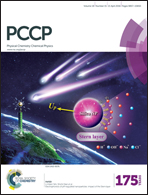Abstract
We have explored the dehydrogenation of methoxy on pristine and defective (111), (100), and (110) ceria surfaces with density functional methods. Methanol conversion is used as a probe reaction to understand structure sensitivity of the oxide catalysis. Differences in reaction selectivity have been observed experimentally as a function of crystallographically exposed faces and degree of reduction. We find that the barrier for carbon–hydrogen cleavage in methoxy is similar for the pristine and defective (111), (100), and (110) surfaces. However, there are large differences in the stability of the surface intermediates on the different surfaces. The variations in experimentally observed product selectivities are a consequence of the interplay between barrier controlled bond cleavage and desorption processes. Subtle differences in activation energies for carbon–hydrogen cleavage on the different crystallographic faces of ceria could not be correlated with structural or electronic descriptors.


 Please wait while we load your content...
Please wait while we load your content...